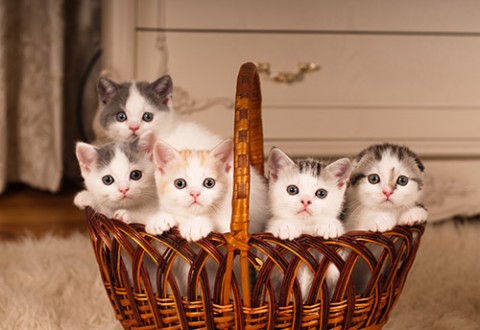Here we are, smack dab in the midst of the feline phenomenon referred to as “kitten season.” Have you heard of it yet? If not, this is the time of year when every unspayed, queen (female cat) is likely to have a belly full of babies, or a litter of youngsters by her side. It is during kitten season when humane societies and animal shelters are teeming with youngsters of all shapes, sizes and colors. It’s a great time to adopt from a shelter!
Why do kittens arrive seasonally?
Kitten season occurs seasonally because the queen has evolved into a “seasonally polyestrous” creature, meaning she comes into heat only during a particular time of year— during this time she is capable of having multiple pregnancies. In the Northern Hemisphere, the feline breeding season begins in very early spring and may persist throughout the summer months. Peak seasons are February through March and May through June. Throughout the rest of the year, the reproductive cycle goes into a state of dormancy referred to as “anestrus.”
Why are cats so prolific?
The domestic cat has long been recognized for her fertility. In fact, the feline was worshipped as a symbol of fertility in ancient Egypt. Bastet, the Egyptian goddess of fertility, was portrayed as a cat.
Unspayed kitties typically experience their first heat cycle (estrus) sometime between five and nine months of age. A queen who is in heat is exceptionally likely to become pregnant for the following reasons:
- A female cat will repeatedly come into heat, approximately every two weeks, throughout the entire breeding season.
- A queen who is in heat is quite the precocious creature. She will do whatever it takes to find herself a tomcat, and she will breed with multiple males.
- The domestic cat is an induced ovulator— her eggs lie in waiting until 30 to 50 hours following copulation, at which time they are released from her ovaries. This timing ensures that the eggs and sperm cells encounter one another.
- During the breeding season, queens quickly come back into heat after giving birth, even before their kittens are weaned.
All of these factors greatly enhance the likelihood of producing a litter, or two, or three during a breeding season. Allowed to breed naturally, a queen might easily produce in the range of 50 to 150 kittens over the course of ten years. Unfortunately, many of these kittens will end up in shelters or euthanized.
How can you help control kitten season?
All of this information makes a strong case for spaying your female kitty before she ever comes into heat. If you’re thinking you’ll simply keep her inside, away from any tomcats, you may be in for a bit of a life disturbance. Cats in heat have been known to drive their humans crazy by vocalizing 24 hours a day, constantly being under foot, rolling around on the ground, and, for all practical purposes, shouting out to the world, “I am in heat!!” This will go on for weeks at a time. During kitten season, it’s not uncommon for sleep-deprived cat lovers to arrive at the veterinary hospital in a state of desperation pleading, “Please, spay her right now!”
Editor’s Note: In addition to spaying your cats, you can also consider adopting from shelters. You can save a life and make a new friend, forever!
If you have any questions or concerns, you should always visit or call your veterinarian – they are your best resource to ensure the health and well-being of your pets.
